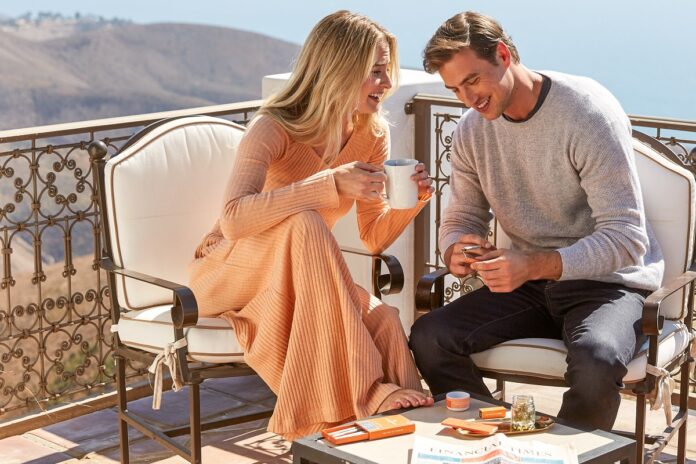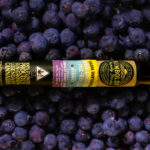Just a few short years ago, the notion of luxury might have seemed completely incompatible with cannabis’s dank aesthetic and anti-establishment roots. Yet today, as commercialization strips the plant of its longtime cultural context and repackages it for new consumers, luxury cannabis has arrived. Collaborations between Edie Parker and MedMen, and Barneys New York opening a luxe accessories emporium, are big public relations moments not only for the stores but also for the industry. But away from these big-ticket crossovers, there are scores of legitimate cannabis businesses vying to bring extravagance to the experience of getting high.
Of all the categories in the industry, at this moment few look as precarious as luxury. The global luxury goods market shrank by 23 percent in 2020. Cannabis largely has been spared devastating contractions, but that doesn’t mean consumers aren’t quickly reprioritizing and determining value differently.
As more states legalize cannabis and California enters its third year of recreational use in the midst of a global recession, several questions arise. What’s in store for the luxury cannabis category? Is it giving consumers what they really want? Should luxury businesses be planning to hedge further down-market?
To answer those questions, we will sidestep the flashy gimmicks and look specifically at cannabis consumable brands and retailers that have staked out an affluent section of the market composed of consumers prepared to spend extra, routinely, on something special. We spoke to nine cannabis industry executives from the retail, brand, and analytics sectors and commissioned a 1,000-person national online survey to get real consumer perspective and actionable insight.
But first, we must define “luxury.” There is a distinct difference between luxury and premium, and the distinction is crucial in the cannabis consumables category. Premium means high quality driving high price and thus creating high value. Luxury is subtler and the value more opaque. Luxury certainly shares a correlation between high quality and a high—often excessive—price tag. But the term also suggests exclusivity and indulgence, with products deriving intangible value from the influence they exert on consumers’ self-image and public perception. This makes luxury particularly subjective, difficult to classify, and thus difficult to measure.
“Defining ‘luxury’ in the legal cannabis category is very challenging,” said Kelly E. Nielsen, vice president of analytics and insights at BDSA (formerly BDS Analytics). “In alcohol, price is nearly always an indicator of premium and luxury. Take a category like scotch, where prices can range from under $20 to thousands of dollars per bottle.
“The legal cannabis space is much more nuanced, because price on its own can be misleading,” Nielsen continued. “It’s always important to look at the combination of price and milligram content as well as confirming the brand aims to elevate the user experience and fit with a high-end lifestyle through positioning, packaging, and product benefits offered.”
According to BDSA, this trio of upper-tier market positioning, elevated presentation, and clear product benefits can ensconce a premium product in the luxury category. But what role does scarcity—typically a reliable driver of the perception of luxury—play in the cannabis consumables market?
Take Napalm’s ultra-exclusive $150 pre-roll housed in a glass grenade, or a novel Cookies strain like Cheetah Piss, which might see lines around the block when it drops. Could either be considered “luxury?” On paper, they are exclusive, scarce products that command comparatively high price tags, are of unquestionable quality, and in the case of Napalm, have “elevated” packaging. Premium yes, though few would argue they are luxury items.
California flower brand Canndescent, on the other hand, has irrefutable luxury credentials, minus scarcity and exclusivity. Available in around half the stores in the state, the brand is among the most widely available and found its competitive dimension against the likes of Jungle Boys and LA Kush in consistency as opposed to novelty.
“It’s all about consistency over time,” said Adrian Sedlin, Canndescent’s founder and chief executive officer. “If you fell in love with one of our offerings, it’s always going to be there for you, and to exactly the same consistency in quality each and every time.”
Before launching in 2015, Sedlin identified the affluent metropolitan professional as a major new consumer demographic cresting over the horizon. He believed members of that cohort could be introduced to the plant by the right brand that presented quality with a discreet sophistication. When Canndescent debuted with its elegant terracotta packaging and ornate serif typeface, the brand became the only grass permissible to pass at a Malibu garden party.
A crucial aspect of the company’s outreach to the Malibu garden party crowd was to pioneer effect-based SKU nomenclature (Cruise, Create, Calm, etc.). This helped Canndescent communicate clear expectations to an audience indifferent to—and often put off by—the previous generation of notoriously playful strain names, and confused by the increasingly irrelevant indica/sativa categorization. The strategy has been adopted by other brands and stores and has proved an extremely effective communication bridge for all new consumers, not just those in the upper end of the market.
While Canndescent is the most visible of the luxury brands, a lot of smaller players are exploring niche offerings and fighting for market share. After Kiva’s immensely successful infused chocolate set a high bar for classy edibles, brands like Défoncé, Coda Signature, and 1906 followed suit. In the vape category, Beboe, Bloom Farms, and Stiiizy recognized hardware could be a fashion accessory, while the once-spluttering beverage category now has Italian-style apéritifs and weed wine.
Although a clean definition remains elusive, luxury brands share a handful of key characteristics: They sell premium products, in terms of both price and quality; they display sophisticated packaging and aspirational marketing collateral; they appeal to the desire to be perceived as cool, refined, or simply rich.
But beyond price and quality, are luxury intangibles really that important?
“We found consumers were very clear that they aren’t interested in products that make claims about being luxury for arbitrary reasons,” said Adriana Hemans, director of demand and special projects for SoapBoxSample, an online market research firm that gathers consumer insights for a variety of industries, including cannabis. “They are interested in products that can demonstrate a specific benefit to spending more.”
mg Magazine commissioned SoapBoxSample to survey 1,000 consumers who had purchased cannabis in the past three months in a bid to understand what motivates their buying decisions. In addition, the survey sought to gage luxury consumers’ associations, preconceptions, and hang-ups when it comes to the product category.
Respondents were evenly split between male and female cannabis users age 21 and older from forty-eight states (excluding South Dakota and Ohio) with 30 percent self-reporting their annual household income as $100,000 or more. Eighty-five percent of those surveyed consume cannabis at least once per week, with 42 percent saying they had purchased a luxury cannabis product in the past twelve months. The survey took place November 10 through 20, 2020, and the results bear a 95-percent confidence level.
At every opportunity, those surveyed reiterated quality is key. When asked to identify and rank their primary motivators for choosing a cannabis product, quality was referenced by 92 percent of respondents, with potency (which for a subset of the global cannabis community is a synonym for quality) coming in at 85 percent. Price was the fifth most important motivator (73 percent). Perception of “luxury or high-end” was referenced by only 45 percent, while elevated packaging and branding trailed further (36 percent), wielding a higher influence over men than women.
Of those who spend more than $250 per month on cannabis consumables, 92 percent indicated quality was very important or extremely important when it comes to selecting products. This suggests the product itself drives purchasing choices among big-spending buyers.
When asked to select from a variety of reasons why they might purchase a luxury cannabis product, more than half (52 percent) said they want the highest quality ingredients. Almost one third (32 percent) indicated they purchase high-end goods because they deserve the best. Interestingly, 25 percent of men, compared to just 9 percent of women, said they would buy a luxury product to “look cool” (although a different adjective might have elicited a different response).
Millennials and Gen Z—the demographic Headset predicts soon will compose three quarters of the market—are the most price-sensitive and are striving to find the sweet spot between quality and price. Very few consumers older than 55 consider things like packaging or brand recognition important. This demographic is motivated chiefly by quality.
“Something we can take from this survey is that consumers are extremely savvy,” Hemans said. “If they are being asked to pay extra, they want to know what they are paying for.”
How retailers are embracing luxury
The evolution from dingy green-cross shops to the temples of opulence that grace mg’s pages each month is among the starkest indicators of how the industry is maturing. To be a luxury retailer, stores need four things: boutique-inspired interior design, excellent service, intentional product selection, and an affluent local customer base enticed by the perception of luxury.
Located in the wealthy Woodland Hills neighborhood of Los Angeles, Atrium is setting a new standard for boutique dispensaries. The open floorplan is bathed in natural light, and glass display cases fit for diamonds are framed by merchandised shelves from which trendy brands beckon the well-heeled. Around the store, engaged budtenders patiently walk Atrium’s high-net-worth customers through branded modules, zeroing in on their needs and pairing them with a selection from a menu bearing more than 2,800 SKUs.
“Our typical customer is fairly wealthy and is looking to have an enjoyable experience and to be able to talk to someone versus going into a typical shop,” explained Ty Mehra, the store’s buyer.
Atrium developed an internal customer service system called GUEST (greet, understand, educate, sell, then review) for new customers. Atrium’s clientele includes many celebrities, some of whom forgo their local dispensaries and travel across Los Angeles just to get the shop’s special service.
Synchronicity Holistic, another California dispensary that has balanced flawless design and excellent service, has been dubbed the “Cartier of cannabis.” Valentia Valentine, the 66-year-old serial entrepreneur who owns the lavish $6 million store in Carmel-by-the-Sea, has been living with multiple sclerosis since the late 1980s. Her experiences as a wealthy older woman using cannabis as medicine guided the store to a unique intersection of elegance and earnest wellness. Valentine invested in hiring a pharmacist and a staff of trained nurses to guide her mostly older, wealthy customers toward products for specific health challenges and ailments, with daily follow-up care being a key differentiator.
“Patient care is absolutely paramount for me,” Valentine said. “Everything else follows that. When people feel cared for, they come back.”
A curious trend has developed: brands crossing over into retail, with dosist perhaps the only operation verging on “luxury.” Presumably inspired by flagship stores belonging to brands like Hermès, dosist invested in its own branded stores in a bid to own the end-to-end experience of its product. As both of the company’s Los Angeles locations closed in 2020, we’d be remiss not to question the wisdom of a capital-intensive departure from what dosist does best: making high-end vapes.
Challenges in the market
It would be easy and perhaps misguided to infer the pandemic-induced recession will ring a death knell for luxury cannabis. If anything, many wealthy Americans appear poised to emerge from the crisis richer than they were when it began. Regardless, several major challenges face luxury brands and retailers even in the best of times.
If luxury is about a lot more than just the product presentation (which consumers seem to believe), one ongoing headache is the requirement to source, cultivate, and deliver luxury at every touchpoint. The feat is difficult enough in an established industry under a thriving economy. In a nascent, once-clandestine marketplace with a patchwork of hastily developed regulations and a wide gamut of operating standards, achieving and maintaining a luxury reputation can be grueling.
Canndescent’s Sedlin explained his company forewent a state-by-state expansion because few markets could deliver the end-to-end quality the brand promised. Instead, Canndescent deepened its focus on California, clung to the company’s core competencies (cultivation, distribution, presentation), and introduced a pair of lower-tier flower brands: Good and Baker’s. “It’s better to start at the high-performance end and go down-market,” Sedlin said. “Nike built its reputation on developing high-performance products for athletes before it made more accessible consumer options. In our case, we chose to develop alternative brands that are totally separate from Canndescent so we didn’t tarnish the name and luxury reputation before most of the [U.S.] market got to experience the product.”
The strategy, called “diffusion line,” commonly is used by couture fashion brands (think Armani Exchange) to broaden their consumer base and open new revenue streams from existing sources. While the approach worked for Canndescent, which is big and well-capitalized, BDSA’s Nielsen warned creating a diffusion line isn’t without its challenges. “The farther removed you are from your parent brand, the less likely you are to be cannibalistic but the harder it is to leverage parent brand-awareness or reputation.”
A challenge unique to flower brands that overinvest in packaging and underinvest in the product is many retailers prefer to display buds in unbranded, magnified jars. In addition to aesthetics, there’s a psychology-based sales strategy at work there: The technique sets up consumers to make decisions based on quality (trichomes, density, purple hairs specifically, according to some survey respondents), potency, and price without packaging influencing the purchase.
But it’s crucial to note almost all consumables on dispensary shelves are presented in their original packaging within reach of just about everyone who walks through the door.
Let’s return to Canndescent, whose eighths retail for around $60—by no means cheap, but competitively priced with much of the top-shelf flower in California and a rung below ultra-premium brands like Alien Labs and Connected. “Let’s say you can get four joints that five people can enjoy together from an eighth. You’re able to deliver twenty user experiences for $60. It’s $3 for a world-class, two- to three-hour experience,” Sedlin said. “It’s so inexpensive relative to the luxury treats people spend their money on.”
This gets to the heart of a tricky issue luxury cannabis companies must navigate: If prices are competitive, does the perception something is financially out of reach turn potential customers away?
“We’ve been battling the misconception that we’re more expensive than everyone else since we opened our doors,” said Paul Cotterell, general manager at The Leaf El Paseo, a boutique dispensary in the toniest shopping district in Palm Desert, California. “Our prices are equivalent and often cheaper than a lot of our competitors, but because of where we are and our presentation, we are perceived to be out of reach to some folks.”
The sentiment was echoed by some consumers in SoapBoxSample’s survey. When asked why they had not purchased a luxury cannabis product, they responded with answers like “To me, luxury means it’s probably something I can’t afford” or simply “way too expensive.” Although a particular product or price wasn’t defined, the perception was “luxury presentation means it’s out of my reach.”
For luxury stores, keeping their prices competitive while building custom interiors and hiring a higher caliber of staff slows the path to recouping the investment, particularly when the new consumers they are trying to attract tend to shop less frequently.
“You can go after these new consumers, but the reality is they make up a substantially smaller portion of where the money’s coming from in this category,” Nielsen cautioned.
Adapting to a rapidly changing market
Cannabis has been one of the few economic success stories of the pandemic, but a lot of consumers are becoming price-conscious and considerably more discerning about where value actually lies. This is making luxury merchandise’s je ne sais quoi seem less enticing, particularly when you’re stuck at home with no one to impress.
The big takeaway should be quality and price are the most important factors to the vast majority of cannabis consumers.
Luxury brands should focus on defining where their customers identify quality (potency, process, region, ingredients, etc.) and prominently promote that aspect of their products. Packaging still plays an important role in delivering the information and differentiating the brand, but going overboard can turn off potential customers, who may feel they can’t afford the price—or worse, suspect they are paying for marketing at the expense of quality.
Luxury retailers can stand out by adding value in a way others don’t. Atrium’s exceptional customer service and extensive menu have made the shop a destination for the upper crust in Los Angeles County. As well as being one of the most beautifully designed dispensaries in the country, Synchronicity has found a devoted audience by investing in wellness professionals and patient care.
Like luxury brands, luxury stores also should be aware the way they present themselves may repel people. Some consumers perceive interior design, like packaging, represents a bill they must foot on top of product costs, which already include branding expense (and that’s to say nothing of taxes).
But maybe we’re missing the point. Perhaps luxury, by its very nature, should exclude more people than it welcomes. If everyone can have something, is it really a luxury item? And if this mysterious intangible value is supposed to deter those who prioritize tangible value, then all may be working as intended and there’s nothing to see here.
With prices largely capped and the consumers drawn to luxury experiences appearing to spend at much lower frequency, does luxury’s low-volume, high-margin approach create viable businesses in a hyper-competitive industry like cannabis?
Perhaps the pivotal year ahead—with the pandemic defeated and economic recovery in process—will provide more clarity.














[…] a healthy retail landscape is essential for the area’s continued success. Hosting elevated and luxury dispensaries in the city not only contributes to the destigmatization of cannabis retail but also positions the […]